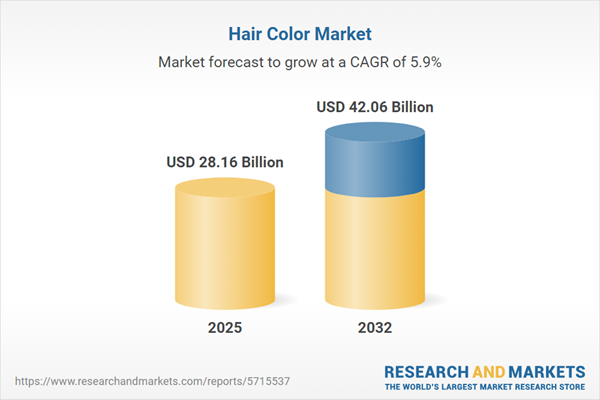Speak directly to the analyst to clarify any post sales queries you may have.
The global hair color market is undergoing significant shifts, presenting senior decision-makers with high-impact opportunities across product innovation, digital transformation, and evolving consumer preferences. Strategic insights are essential as competition intensifies and new regulatory landscapes emerge.
Market Snapshot: Hair Color Market Size and Forecast
The Hair Color Market grew from USD 26.67 billion in 2024 to USD 28.16 billion in 2025. It is expected to maintain upward momentum at a CAGR of 5.85%, reaching USD 42.06 billion by 2032. This trend underscores an expanding market shaped by consumer demand for personalization, digital engagement, and wellness-oriented solutions.
Scope & Segmentation: Comprehensive Coverage of the Hair Color Landscape
- Product Forms: Cream, foam, gel, liquid, and powder formats offer diverse solutions for unique application preferences and usage scenarios.
- Formulation Types: Ammonia-based and ammonia-free classifications meet varying safety, performance, and sensory needs across consumer groups.
- Color Duration: Permanent, semi-permanent, and temporary options accommodate users ranging from those seeking lasting results to those desiring short-term experimentation.
- End Users: Solutions targeted for men, women, and unisex requirements reflect the expanding inclusivity and reach of the category.
- Distribution Channels: Offline channels include pharmacies, specialty stores, supermarkets, and hypermarkets. Online retail platforms broaden access and enhance product discovery.
- Usage Contexts: DIY (at-home) kits support increasingly confident consumers, while professional (salon use) colorants remain essential for expert services.
- Geographic Coverage: Americas, Europe, Middle East & Africa, and Asia-Pacific, with deeper granularity on key markets in each region.
- Company Analysis: In-depth insights on sector leaders, including Amway Corporation, Coty Inc., Henkel, L'Oréal S.A., Revlon, Inc., and Unilever Plc, among others.
Key Takeaways: Strategic Insights for Senior Stakeholders
- The intersection of wellness, sustainability, and digital enablement drives market transformation, with consumers seeking ammonia-free, multi-benefit, and eco-certified formulations.
- Augmented reality tools and virtual try-on experiences are reshaping digital sales channels, strengthening engagement, and reducing purchase hesitation among at-home users.
- Ingredient transparency and safety statutes are increasing, prompting accelerated innovation in next-generation colorants, green chemistry, and packaging solutions.
- Tariff measures enacted in the United States have increased input costs, creating pressure on margins and influencing new supply chain and sourcing strategies.
- Regional differences remain critical: North America leads in digital adoption, Europe prioritizes regulatory compliance and sustainability, while Asia-Pacific demonstrates the fastest pace of product diversification and online retail expansion.
Tariff Impact on Cost Structures and Supply Chains
The 2025 introduction of US tariffs on imported ingredients and packaging components has amplified cost pressures across production and logistics. Larger brands have leveraged scale and vertical integration to mitigate these impacts, whereas independents face challenges in margin preservation. Resulting shifts include supplier diversification, nearshoring initiatives, and investment in resilient manufacturing strategies.
Methodology & Data Sources
This report synthesizes qualitative and quantitative findings from structured interviews with industry professionals, consumer surveys, regulatory filings, supplier data, and competitive intelligence platforms. Robust triangulation and scenario analysis techniques ensure comprehensive perspective and reliability in forecasting and strategic evaluation.
Why This Report Matters for Decision-Makers
- Pinpoint growth levers by understanding the interplay of consumer trends, ingredient innovations, and market regulations in the hair color industry.
- Enhance risk management and supply resilience with actionable insight into tariff impacts and evolving distribution models across global regions.
Conclusion
This report provides the actionable intelligence necessary to drive innovation, strengthen competitive positioning, and unlock sustainable value within the evolving global hair color market.
Additional Product Information:
- Purchase of this report includes 1 year online access with quarterly updates.
- This report can be updated on request. Please contact our Customer Experience team using the Ask a Question widget on our website.
Table of Contents
3. Executive Summary
4. Market Overview
7. Cumulative Impact of Artificial Intelligence 2025
Companies Mentioned
The companies profiled in this Hair Color market report include:- Amway Corporation
- CavinKare Group
- Combe
- Coty Inc.
- Davines S.p.A
- eSalon.com LLC
- Godrej Consumer Products Limited
- Henkel AG & Co. KGaA
- Herbatint
- Himalaya Wellness Company
- Hoyu Cosmetics (Thailand) co., ltd.
- Hygienic Research Institute Private Limited
- Kao Corporation
- Lush Retail Ltd.
- L’oreal S.A.
- Madison Reed, Inc.
- Marico Group
- oVertone Color
- Paradyes
- Procter & Gamble Company
- Revlon, Inc.
- Satin Hair Color
- Shiseido Company, Limited
- The Estée Lauder Companies Inc.
- Unilever Plc
Table Information
| Report Attribute | Details |
|---|---|
| No. of Pages | 194 |
| Published | November 2025 |
| Forecast Period | 2025 - 2032 |
| Estimated Market Value ( USD | $ 28.16 Billion |
| Forecasted Market Value ( USD | $ 42.06 Billion |
| Compound Annual Growth Rate | 5.8% |
| Regions Covered | Global |
| No. of Companies Mentioned | 26 |









